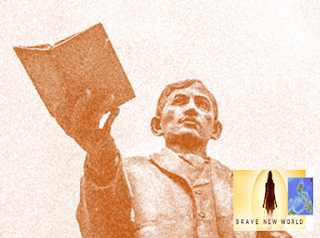The above image of PH National Hero Jose Rizal as “The Happy Martyr” – my title – is from an original photograph[1] from Shutterstock.com that I painterized.
You doubt Jose Protacio Rizal y Mercado was happy to offer his life – not simply his book – to his beloved Philippines? I learned that 13 years ago translating his valedictory “Adios, Patria Adorada” – here is the very first stanza[2] (30 December 2017, “Jose Rizal, UP Oblation & 3 Lessons For The Nationalist Communicator,” Creative Thinkering):
Adios, Beloved Country
(Translation by Frank A Hilario, 2007)
Adios, beloved country, EarthLove of the Sun,
Pearl of the Sea Orient, Eden in ruins bad!
I go give gladly my life shrunk and forsaken;
And were it more brilliant, more fresh, more floral then,
Would for you give I still, still I give for your good.
Now you know your National Hero Jose Rizal better!
The original was untitled; note that my title comes from the first line of the poem, which is the rule in a poem or sonnet without a title given by the author – other Rizal translators gave the uninspiring, despairing title “My Last Farewell.”
Look at the image again: My choice of him extending a book – he is offering his worldwide knowledge of Agriculture, Business, Education.
Michael “Xiao” Chua says in his essay “Rizal ‘Imagineering’ The Nation In Dapitan[3]” (14 July 2018, Manila Times):
… Rizal’s concept of the Nation as manifested in his La Liga Filipina: A united archipelago in a “catipunang malago” [luxuriant society] where change comes from the grassroots in the shared intentions of each individual and where people show “damayan” [reciprocal help] – educating each other, learning together and encouraging agriculture and commerce together.
I am a wide reader but I did not know of what Mr Chua is saying above! But I’m happy because I find there the requirements my country needs today to catapult the Philippines into the First World.
Yes Sir! Yes Ma’am! What the Philippines needs right now are 3 things that Rizal went into in Dapitan:
(1) Multi-Crop Agriculture –
Anonymous in Weebly say
As agriculturist, Rizal devoted time planting important crops and fruit-bearing trees in his 16-hectare land (later, reaching as large as 70 hectares). He planted cacao, coffee, sugarcane, and coconuts, among many others.
(2) Agri Business –
With Ramon Carreon as partner, Rizal did business in the fishing, hemp and copra industries. They were more successful in hemp, shipping the product to a foreign firm in Manila.
(3) Universal Education–
Following La Liga Filipina precepts, we must unite in a peaceful way so that together we can work for the good of the entire archipelago. Our education must be of Unity in Diversity.
Not to forget that he was teaching boys, a total of 21 until the end of his exile in July 1896[5] (Anonymous). No tuition; instead, the boys paid with their labors – and learned besides – working in the garden, fields and construction projects of their teacher.
Our National Hero is teaching us still!@517
[1]https://www.shutterstock.com/search/jose+rizal+monument
[2]http://creativethinkering.blogspot.com/2017/12/jose-rizal-up-oblation-3-lessons-for.html
[3]https://www.manilatimes.net/2018/07/14/opinion/analysis/rizal-imagineering-the-nation-in-dapitan/419187/
[4]https://bshmjoserizal.weebly.com/our-hero-jose-rizal/chapter-eight-jose-p-rizals-exile-in-dapitan-1892-1896
[5]https://bshmjoserizal.weebly.com/our-hero-jose-rizal/chapter-eight-jose-p-rizals-exile-in-dapitan-1892-1896

Comments
Post a Comment